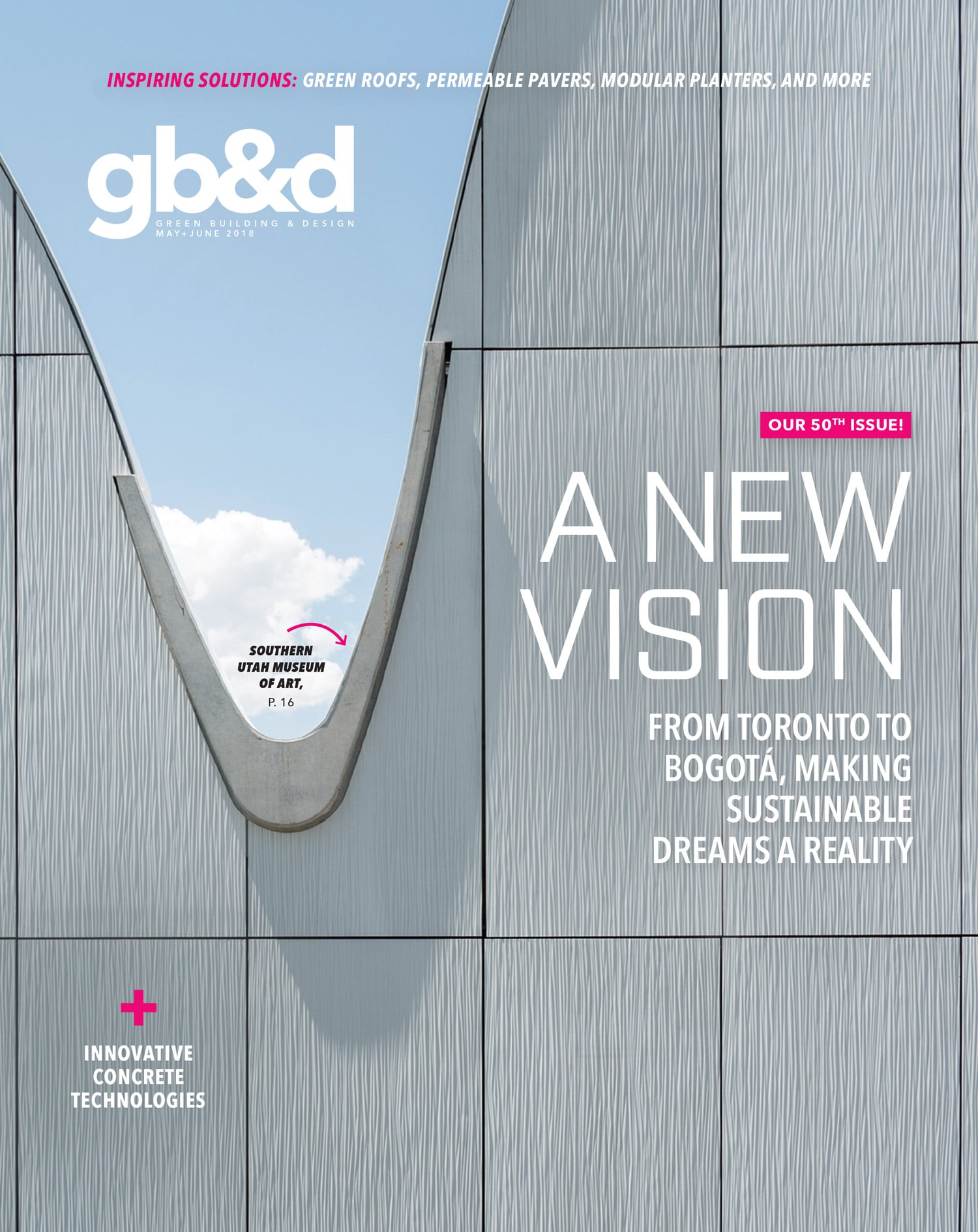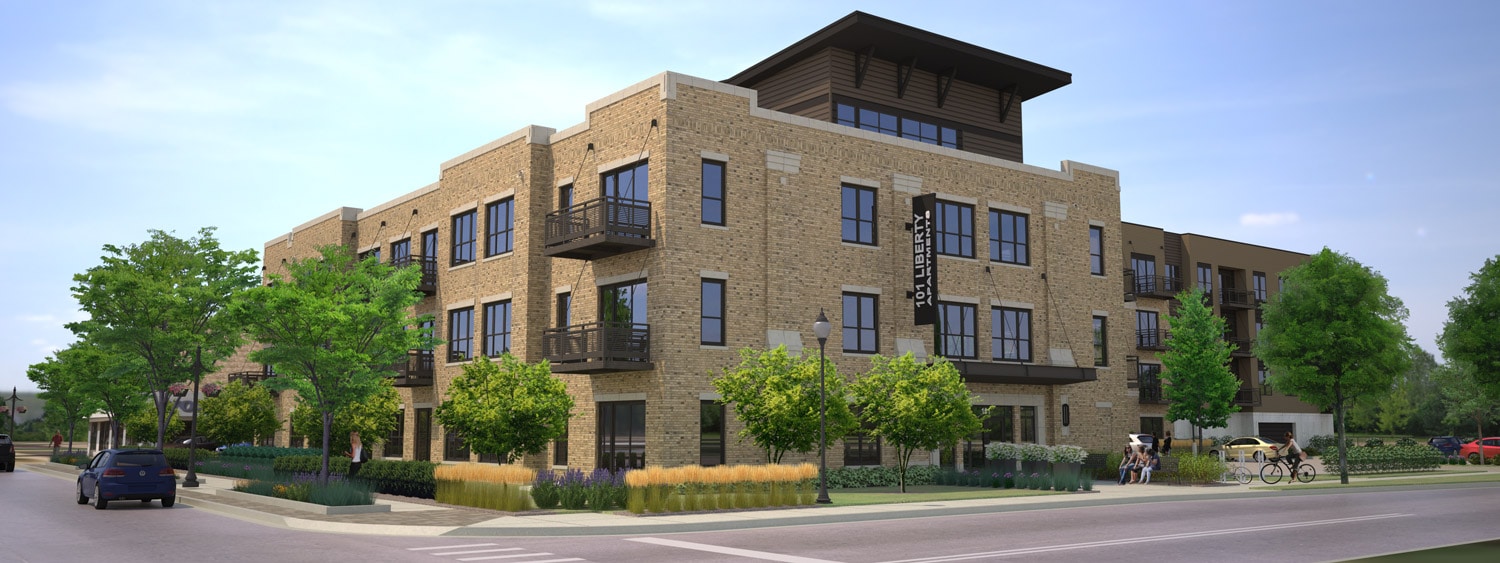
Keeping sound contained is a must for residences, and USG helps you keep things quiet. [Photo: Courtesy of HKM Architects + Planners, Inc.]
USG offers cost-effective and sustainable gypsum concrete underlayment for your next building.
The number one complaint of people living in multi-family housing is noise—they can hear their neighbors’ footsteps or music blasting overhead. “The better sound containment you can achieve, the better the user experience, ultimately yielding to better tenant retention for an owner,” says Chicago-based architect Adam Thoma of HKM Architects + Planners.
Imagine a building that not only meets fire and sound codes but exceeds them. Now, imagine a cost-effective solution that creates a quiet, safe living experience for tenants. It’s all possible with gypsum concrete underlayment.
When Thoma is working on designs for a floor assembly to be used in multi-family housing projects, gypsum concrete underlayment from USG is his first stop. The USG product recently received UL Environment’s GREENGUARD Gold certification for low chemical emissions.
What is It?
Gypsum concrete is created by mixing sand and gypsum composed of hydrated calcium sulfate. It occurs mainly in sedimentary deposits and is both mined and synthetically produced from cleaning the combustion gases of coal-burning power plants.
USG invented and was the first company to manufacture gypsum concrete, and for many years they were a toll manufacturer for other companies. They put their own brand of higher strength gypsum concrete—Levelrock®—on the market in 1999. When USG introduced Levelrock Brand Floor Underlayment at a minimum of 2,500 psi compressive strength, the typical gypsum concrete underlayment being poured was 1,500 psi compressive strength.
Gypsum concrete comes in powder form and is mixed onsite with locally sourced sand and water—a more sustainable method of application. It’s applied to the building floor with a hose and self-levels, leaving a smooth finish. “In one day, a crew of five or six can pour 25,000 to 30,000 square feet of gypsum concrete at three-quarters of an inch thick, making it less labor-intensive than applying traditional concrete,” says Alex MacDonald, manager of strategic accounts for USG.
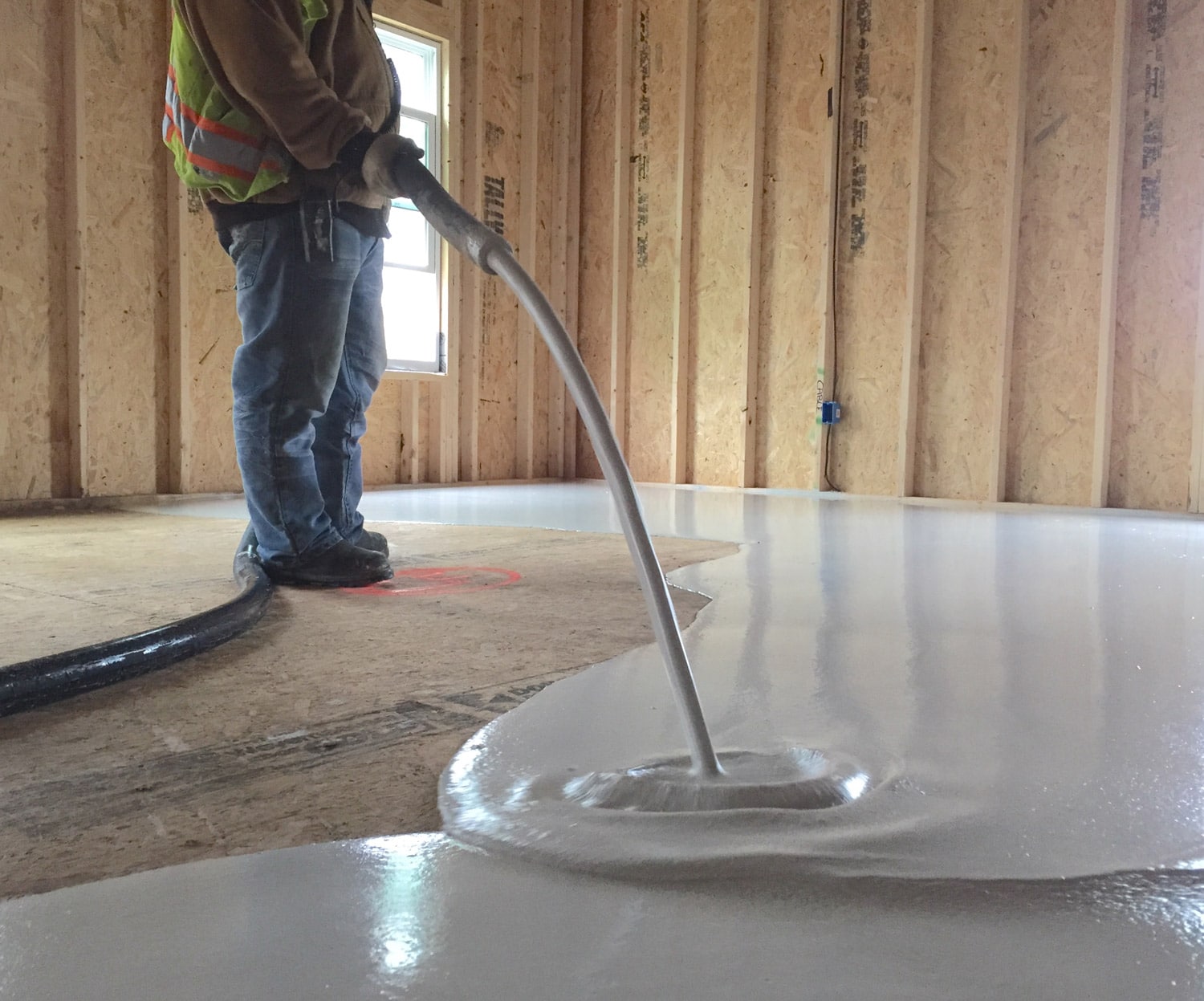
A small crew can pour up to 30,000 square feet of gypsum concrete at three-quarters of an inch thick in one day, so it’s less labor intensive. [Photo: Courtesy of USG]
Getting More for Less
Meeting the building code for fire-rated floor/ceiling assemblies is a requirement for architects, builders, and owners. Before gypsum concrete, building owners had to apply a minimum of one-and-a-half-inch of lightweight concrete to meet requirements. Lightweight concrete is not very crack-resistant because it shrinks when it cures. With gypsum concrete, as little as three-fourths of an inch is required to get a fire rating for a floor/ceiling assembly.
“When USG introduced the first gypsum concrete, we were able to reduce the cost and offer a more crack-resistant floor at 50% of the underlayment thickness,” MacDonald says. Unlike other thin types of concrete, gypsum concrete does not shrink when it cures, and it’s significantly more crack-resistant. This allows it to be poured thinner.
In a non-combustible building, gypsum concrete can be poured over a corrugated steel deck at only one-inch thick. That floor/ceiling assembly has a two-hour fire rating and, at only 13 pounds per square foot, allows you to build higher with load-bearing cold-formed steel. It’s a faster and lighter way to build a mid-rise residential project.
The chemical makeup of gypsum concrete makes it an ideal fire barrier—increasing the time it takes for the temperature to rise on the floors above. “Chemically speaking, gypsum is very unique,” says Brett Fleury, product marketing manager for performance flooring at USG. “Two molecules of water are chemically bound to the gypsum. When the gypsum is heated to a high temperature, the chemically bound water absorbs the rising heat, thus serving as a heat sink during a fire test.”
FROM OUR MAY+JUNE 2018 ISSUE
The preferred publication of leading green professionals.
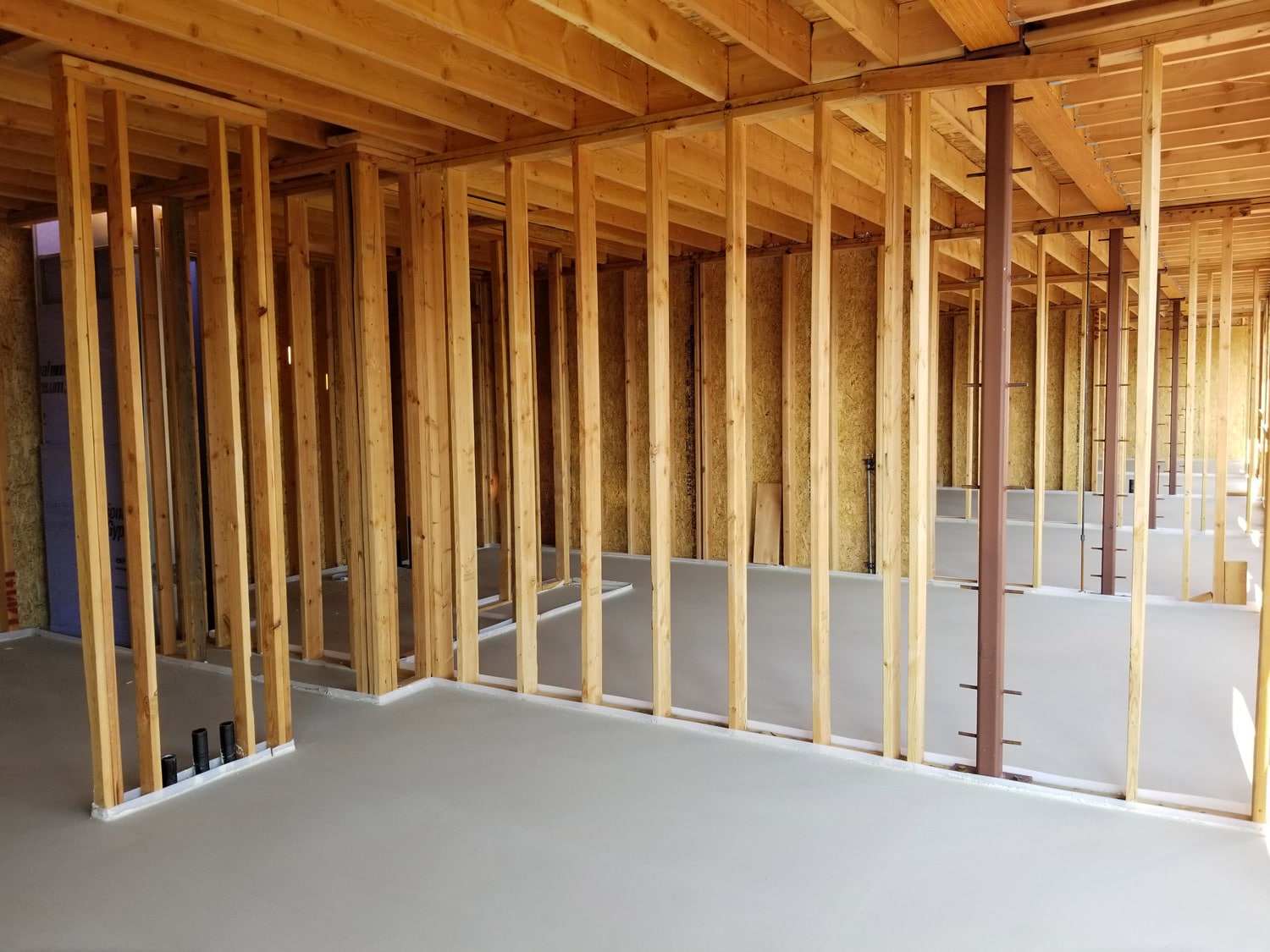
The makeup of gypsum concrete makes it an ideal fire barrier—increasing the time it takes for the temperature to rise on the floors above. [Photo: Courtesy of USG]
Quieter Living
When gypsum concrete came to fruition in the 1970s, there was no sound code for multi-family buildings. Most buildings used carpet and a carpet pad, items that were relatively inexpensive, and they addressed both airborne and structure-borne sound transmissions. As higher-end hard surface flooring options increased in popularity, so did the need to address structure-borne sound with sound attenuation systems that work in concert with gypsum concrete.
Today’s minimum requirements for sound transmission between dwelling units and other public areas in a building are called out in Section 1207 of the International Building Code. In a typical floor/ceiling assembly, the code minimum for sound transmission class (STC) is easy to achieve.
“The best way to dampen airborne sound, or STC, is mass, and the best mass is a high-density, crack-resistant cementitious material without control joints,” MacDonald says. “With hard surface floor coverings like vinyl plank, ceramic tile, or engineered hardwood on the other hand, the IIC (Impact Isolation Class, which measures a floor assembly’s ability to absorb impact sound) will always fall below the code required 50 IIC when there is no sound mat. Placing a sound mat under the gypsum concrete decouples the gypsum concrete mass from the framing, ultimately making the difference between meeting or not meeting the IIC requirement of Section 1207.”
Unlike other types of sound barriers, a sound mat and gypsum system can be applied under any type of flooring. “Right out of the box, USG’s Levelrock underlayment is going to meet code and allow you to use any floor covering you like,” Thoma says. While there are flooring products on the market with sound backing, they can be costly. “Gypsum underlayments installed over sound attenuation mats are very cost effective. That is the reason we use them,” he says. “It is our go-to system and makes our lives easier.”
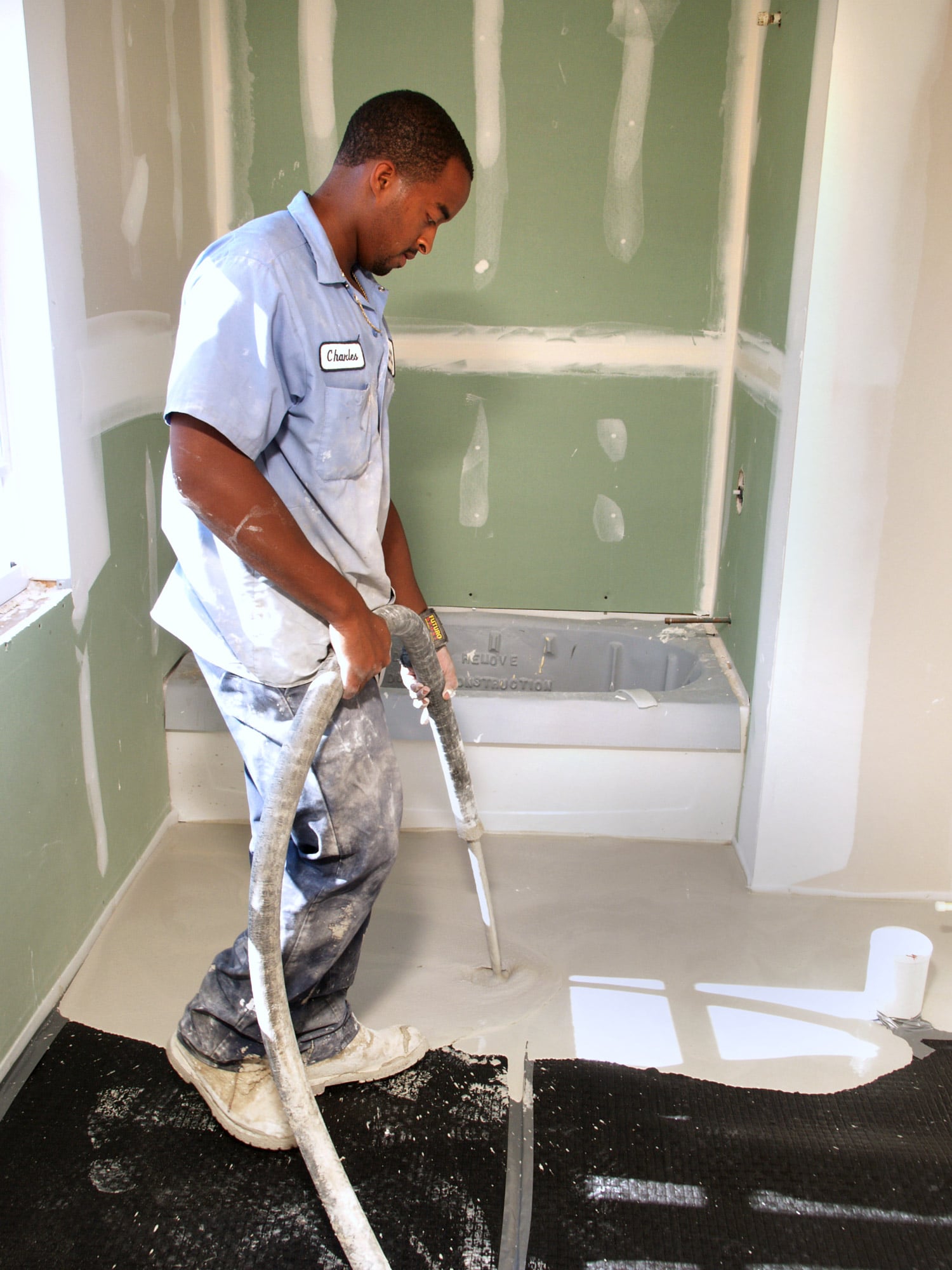
[Photo: Courtesy of USG]
Renovation Solutions
USG’s gypsum products can also be used in renovations. “These buildings were designed only to meet fire code, and the gypsum concrete applied 15 to 40 years ago was very low in compressive strength and just wouldn’t hold up over time,” MacDonald says. “At the lower compressive strengths, you can take your fingernail and gouge right through it. Contractors working on renovations are going into buildings, pulling up the old floor covering, and seeing the crumbling gypsum concrete. They are needing to scoop it up with a shovel, it’s that bad.”
To avoid the potential nightmare of repairing the entire underlayment when floor coverings are updated, USG created a product that can be applied directly over the old concrete. “We came up with an innovative way to repair the lower strength gypsum concrete. We have a very high strength gypsum concrete that can resurface old, weak gypsum. It makes the new floor substantially stronger, so next time you renovate, you won’t have to replace it,” MacDonald says. “High strength gypsum concrete will last longer while maintaining its required fire rating and reduce the amount of waste created on a renovation project.”

